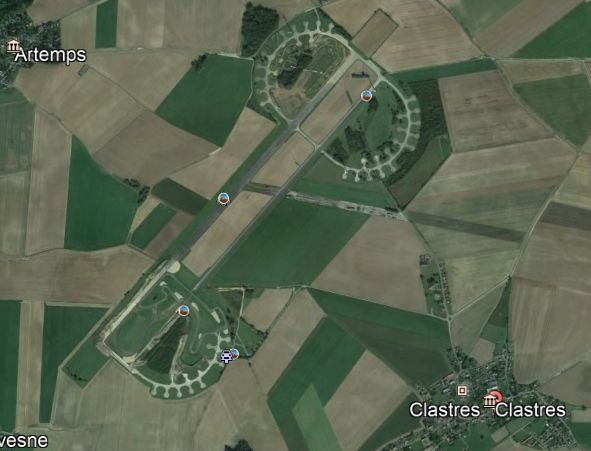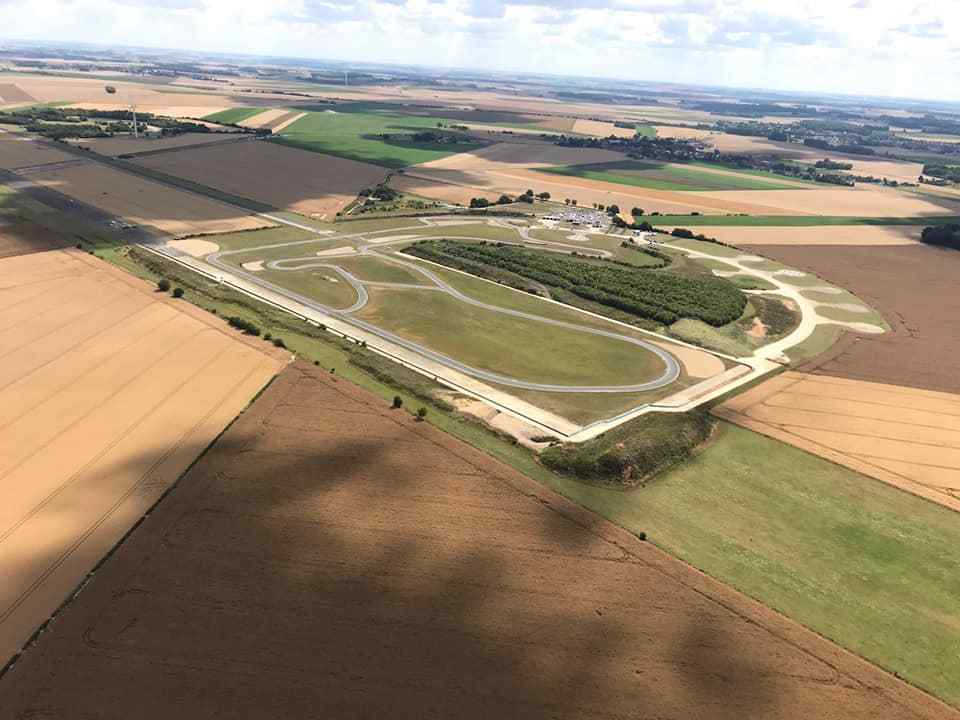
L'histoire du terrain d'aviation dans les archives allemandes (texte en anglais)

Clastres (FR)
(a.k.a. Saint-Quentin – Clastres, St-Simon-Clastres?) (49 45 40 N – 03 13 50 E)
General: airfield in NE France 69 km ESE of Amiens, 11.5 km SSW of St-Quentin and immediately N of the village of Clastres. History: a former French military landing ground that was taken over by the Germans in May 1940 and slowly but extensively developed into an operational airfield with the runways finally completed in summer 1942. No sooner was the work finished than it was relegated to inactive status and the runways and landing area temporarily obstructed. Dimensions: approx. 1740 x 1190 meters (1900 x 1300 yards). Surface and Runways: grass surface. Had 3 concrete runways – (1) 1740 meters (1900 yards) aligned WNW/ESE with an assembly hardstand at the E end; (2) 1690 meters (1850 yards) aligned NE/SW; (3) 1650 meters (1800 yards) aligned NNW/SSE. A wide perimeter road encircled the landing area and connected to the ends of the runways. Each runway equipped with- 106 -Luftwaffe Airfields 1935-45 permanent illumination and visual Lorenz systems, and the landing area with a flare-path and a beam approach system. Fuel and Ammunition: fuel tanks were located in each dispersal area with the main fuel storage probably at the NE end of the airfield. A suspected ammunition dump was under construction off the NW corner along both sides of a road in mid-Jan 44. Prior to that, bomb and ammunition storage was SE of the landing area and off the SW corner. Infrastructure: there was a small hangar for repairs in the Southwest dispersal and some probable workshop buildings at the SE corner. Station HQ, admin offices and stores were in a group of small buildings at the SE corner. Personnel were accommodated in barrack huts erected in Clastres as well as in requisitioned quarters in the nearby village of Essigny-le-Grand. A special branch rail line served the airfield. Dispersal: there were 3 dispersals in Jun 43 – Northeast, Southwest and Northwest – with a total of 37 covered aircraft shelters constructed of blast walls and some with camouflage netting. All 3 were connected to the landing area by taxi tracks. A ladder-type servicing hardstand was located in the Northeast dispersal. Defenses: protected by 1 heavy and 3 light Flak positions in May 43. Ground defenses consisted of 3 reinforced strongpoints and short trenches with machine gun pits. There was some use of barbed wire around the strongpoints. Satellites and Decoys: Clastres/I (a.k.a. Artemps) (49 45 05 N – 03 10 30 E), new satellite ;strip for Clastres airfield located 4 km to the SW and 1.6 km SSW of the ,village of Artemps. Consisted of a single strip measuring 1190 x 185 meters (1300 x 200 yards). Not paved. Believed to be serviceable when first discovered by Allied photo reconnaissance on 17 Jul 44. Remarks: 17 May 43: the landing area and all 3 runways were seen to be temporarily obstructed. 14 Jan 44: runways and landing area remain temporarily obstructed. Prepared strips 90 meters (100 yards) wide have been constructed on the W side of both runways, and all roads leading to airfield have been obstructed with road blocks. 18 Mar 44: runway and landing area obstructions have been removed. 25 Aug 44: bombed and strafed by 9th AAF P-38 Lightnings – runways, hangars, buildings and fuel dumps hit. Operational Units: I., II./JG 27 (Jun 40); 2.(F)/Aufkl.Gr. 123 (Jun 40); III./SG 4 (Feb-Jun 44); Stab/JG 1 (Jun-Aug 44). Station Commands: Fl.Pl.Kdo. A 41/XI (Mar 44); Fl.H.Kdtr. E(v) 230/XI (Apr-Sep 44). Station Units (on various dates – not complete): Luftgaustab z.b.V. 12 (Jun 40); 5./gem.Flak-Abt. 364(o) (Jun 40); Stab/Flak-Rgt. 657 (May 43). |
